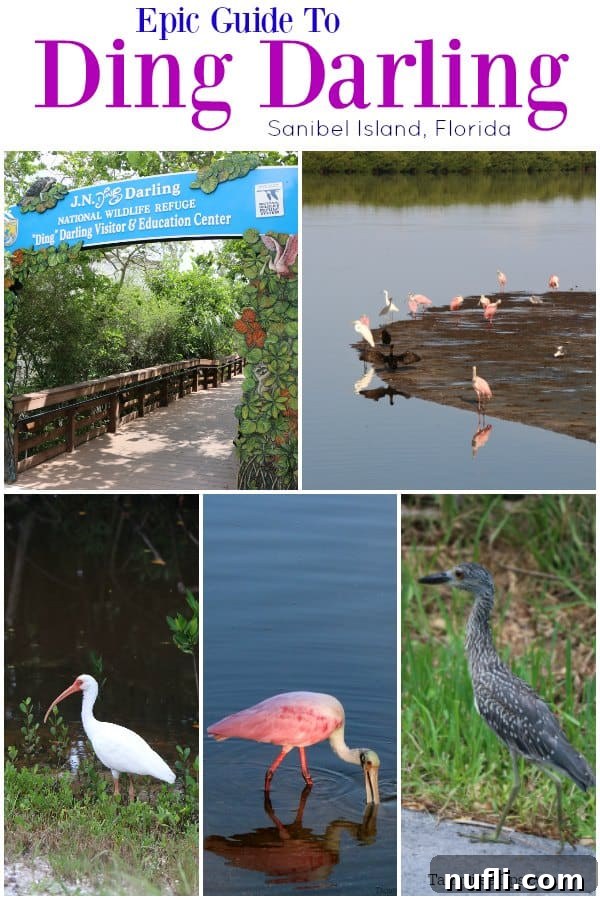Nestled on the idyllic Sanibel Island, Florida, the J.N. “Ding” Darling National Wildlife Refuge stands as a testament to nature’s profound beauty and biodiversity. A visit to this remarkable sanctuary is not merely an activity; it’s an immersive journey into a vibrant ecosystem teeming with life, a truly indispensable experience for anyone exploring Southwest Florida. From the moment you enter, you’ll understand why this refuge consistently ranks as a top attraction, drawing nature enthusiasts, birdwatchers, and families year after year. It’s a place where the wild heart of Florida beats strongly, offering unforgettable encounters with its magnificent inhabitants.

Discover the Wonders of J.N. “Ding” Darling National Wildlife Refuge on Sanibel Island, Florida
The J.N. “Ding” Darling National Wildlife Refuge is renowned for its commitment to conservation and providing a pristine habitat for migratory birds and local wildlife. Established in 1945, the refuge encompasses over 6,400 acres of mangrove forests, seagrass beds, and estuarine waters, making it one of the largest undeveloped mangrove ecosystems in the United States. Its primary purpose is to protect and enhance habitat for migratory birds, endangered and threatened species, and other native wildlife. Visitors are invited to explore this natural treasure, where the breathtaking scenery is matched only by the diversity of its animal residents. It truly is a sanctuary where every turn offers a new discovery, cementing its status as a premier eco-tourism destination on Sanibel Island.
A Birder’s Paradise: Encountering Sanibel’s Feathered Residents
One of the most captivating aspects of Ding Darling is the sheer abundance and variety of its birdlife. As you embark on the scenic 4-mile Wildlife Drive, prepare to be awestruck. The drive winds through various habitats, providing exceptional viewing opportunities. You might round a corner and suddenly find yourself face-to-face with a flock of bright pink Roseate Spoonbills, their unique spatulate bills sifting through the shallow waters for food. These magnificent birds are just one highlight among hundreds of species that call the refuge home, either year-round or during their migratory journeys.
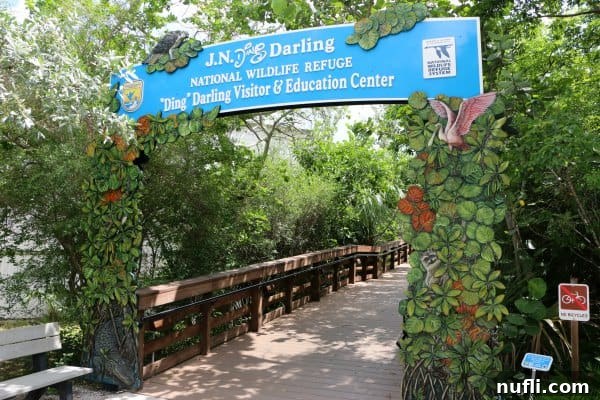
Beyond the iconic Spoonbills, you’ll likely spot elegant Great Egrets, majestic Great Blue Herons, sleek Anhingas, and graceful White Ibis wading through the estuaries. Ospreys soar overhead, ever watchful for fish, while a keen eye might even catch a glimpse of a shy Yellow-Crowned Night Heron. The refuge is a vital stopover point for countless migratory species, making birdwatching a dynamic experience that changes with the seasons. Whether you’re a seasoned birder or a curious novice, the opportunities for observing these incredible creatures in their natural habitat are unparalleled. The calm waters and mangrove fringes create a perfect feeding ground, making it easy to observe their behaviors from the comfort of your vehicle or designated observation points.
Immersive Learning at the Visitor & Education Center
Your journey into the refuge typically begins at the informative Visitor & Education Center, an essential stop for visitors of all ages. This state-of-the-art facility is designed to enhance your understanding and appreciation of the delicate ecosystems you’re about to explore. Inside, you’ll discover a wealth of engaging, hands-on educational displays that cater to both children and adults. Interactive exhibits explain the refuge’s unique estuarine environment, the life cycles of its inhabitants, and the importance of conservation efforts. The information is presented in an easy-to-understand format, making complex ecological concepts accessible and fun.
One of the true gems of the center, and indeed the refuge, is its dedicated team of rangers and naturalists. If you have the chance, we highly recommend meeting Ranger Becky. Her passion for the environment and her encyclopedic knowledge of the area are truly inspiring. During our visit, we were fortunate enough to join one of her interpretive tours, and her insights brought the refuge to life in a way we couldn’t have imagined. She has a unique ability to point out hidden wildlife and explain intricate ecological relationships, often sparking a profound connection to nature in her audience.
Ranger Becky also leads fantastic kids’ programs, igniting a love for the natural world in young minds. We witnessed a heartwarming moment where one of her former students, brimming with excitement, came to greet her. The child’s unbridled enthusiasm, shaking with joy as she recounted all the wildlife she remembered and had recently seen, was a powerful testament to the lasting impact of passionate environmental education. It was truly moving to see a child so deeply engaged with nature and eager to share her discoveries with a park ranger. Such interactions underscore the vital role the center plays in fostering environmental stewardship for future generations.
Beyond Birds: The Diverse Wildlife of Ding Darling
While Ding Darling is a renowned birder’s paradise, its diverse ecosystems support a wide array of other fascinating creatures. Keep your eyes peeled, as you might encounter some of Florida’s most iconic wildlife. Alligators are frequent residents, often seen basking lazily on sunny banks or subtly gliding through the waterways. Remember to always keep a safe distance and never feed wildlife. More elusive, but certainly present, are bobcats, which occasionally make an appearance along the refuge’s trails and roadsides, adding a thrilling element of surprise to your visit.
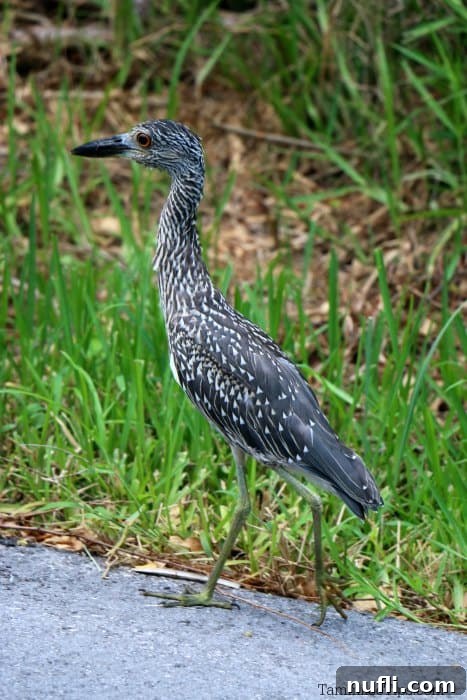
The refuge’s unique blend of fresh and saltwater environments creates an incredibly rich biodiversity. This estuarine system provides critical habitats for species that thrive in brackish waters. Beyond the refuge boundaries but within its surrounding waters, lucky visitors might spot playful bottlenose dolphins swimming and fishing. Manatees, often referred to as “sea cows,” also frequent the warmer, calmer waters around Sanibel, including areas adjacent to the refuge. This ecological diversity means that every visit offers a chance to witness something new and extraordinary, from tiny fiddler crabs scurrying across the mudflats to majestic birds of prey circling high above. The constant interplay between the land and the sea makes Ding Darling a dynamic and endlessly fascinating natural spectacle.
Navigating the Refuge: Driving, Walking, Biking, and the Popular Tram Tour
Exploring J.N. “Ding” Darling National Wildlife Refuge offers a variety of immersive experiences, catering to different preferences and activity levels. The most popular way to see the refuge is via the 4-mile, one-way Wildlife Drive. This paved road allows you to observe wildlife from the comfort of your vehicle, with numerous pull-offs and observation decks for closer views. The drive is particularly magical during sunrise or sunset, when wildlife is most active and the light paints the landscape in stunning hues.
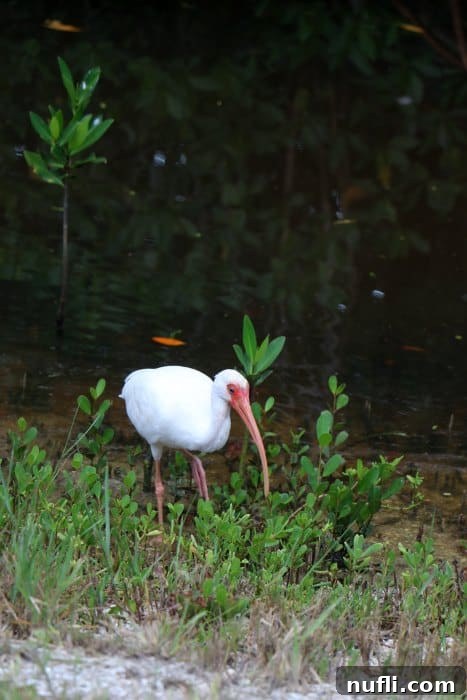
For those who prefer a more active exploration, the refuge offers several walking trails, including the Indigo Trail and Bailey Tract, which provide opportunities to delve deeper into the mangrove forests and observe smaller creatures. Biking the Wildlife Drive is also an excellent option, allowing for a slower pace and more flexibility to stop and appreciate the scenery. You can bring your own bike or inquire about rental options on Sanibel Island.
A highly recommended alternative is the Ding Darling tram ride, which operates multiple times a day with a knowledgeable naturalist on board. Although we didn’t get to experience it personally, we heard glowing reviews about this guided tour. The naturalists undergo rigorous training, ensuring they provide an insightful and engaging commentary on the refuge’s ecology, history, and wildlife. This is a fantastic option if you prefer to relax and let an expert guide your journey, pointing out fascinating details you might otherwise miss. It’s an educational and convenient way to experience the refuge, allowing you to fully immerse yourself without the distraction of driving.
Essential Visitor Tips for an Unforgettable Ding Darling Experience
To ensure your visit to J.N. “Ding” Darling National Wildlife Refuge is as enjoyable and comfortable as possible, consider these practical tips:
Stay Hydrated: Pack Your Water Bottle. Florida’s climate can be warm and humid, especially during the summer months. The refuge does not sell bottled water on-site to minimize plastic waste. However, they thoughtfully provide a water bottle refill station at the Visitor Center. You can also purchase foldable water bottles in the store, making it easy to stay hydrated while exploring.
Banish the Bites: The Absolute Must of Bug Spray. We cannot emphasize this enough: bring bug spray, and apply it generously! Mosquitoes and “No-See-Um” bugs are prevalent, especially in areas close to the water and during dawn or dusk. Forgetting your bug spray can significantly detract from your experience, as we learned the hard way. Some savvy visitors even use mosquito net hats or full-body nets, particularly if they plan on remaining stationary for extended periods, such as for photography. These items are definitely on our list for future trips.
Gear Up for Discovery: Binoculars and Camera. To truly appreciate the diverse wildlife, especially the birds, a good pair of binoculars is indispensable. They allow you to get up-close views without disturbing the animals. And of course, don’t forget your camera! With so many incredible photo opportunities around every corner, you’ll want to capture the beauty of Ding Darling. Consider a lens with good zoom capabilities for bird photography.
Optimal Viewing Times and Seasons. The best time for wildlife viewing is generally early morning or late afternoon, when animals are most active. During these times, the light is also softer, perfect for photography. While the refuge is wonderful year-round, the winter months (November to April) typically offer cooler temperatures and a higher concentration of migratory birds.
Footwear and Clothing. Comfortable walking shoes are a must if you plan on exploring any of the walking trails. Light, breathable clothing is advisable, and consider long sleeves and pants even in warm weather to offer some protection from the sun and bugs.
Leave No Trace. Help preserve this pristine environment by remembering to take out everything you bring in. Stick to marked trails, observe wildlife from a distance, and never feed the animals.
For more detailed planning and the most current information, be sure to visit the official Ding Darling resources. Their website offers comprehensive details on hours, activities, and specific wildlife sightings. You can also connect with their vibrant community on their Facebook page for updates and stunning photos. Additionally, their YouTube channel hosts a collection of engaging videos that provide a fantastic preview of the refuge’s beauty and conservation efforts.
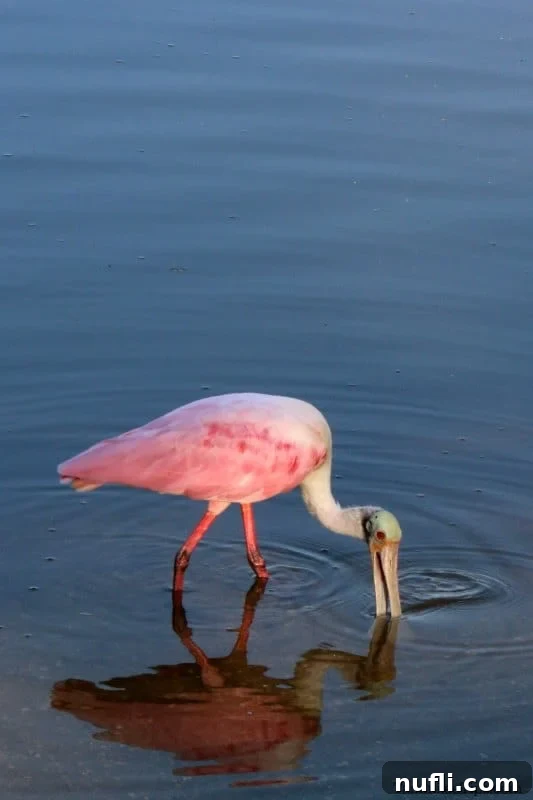
Planning Your Sanibel Island Adventure: More Resources
To further enhance your Sanibel Island vacation, explore these additional resources:
Top things to do on Sanibel Island
Sanibel Island Restaurant Guide
West Wind Inn Sanibel
Sanibel Island Travel Tips
Mailboxes of Sanibel Island
The Bubble Room – Captiva Island
Sanibel Dolphin and Sunset Cruise
Conclusion: Your Journey into Nature Awaits
A visit to the J.N. “Ding” Darling National Wildlife Refuge is more than just a sightseeing trip; it’s an opportunity to reconnect with nature, learn about vital conservation efforts, and witness the stunning biodiversity of Florida. Whether you choose to drive, bike, walk, or take the educational tram, you’re guaranteed to create lasting memories. So, pack your essentials, embrace the wild, and prepare for an unforgettable adventure into the heart of Sanibel Island’s most precious natural gem.
